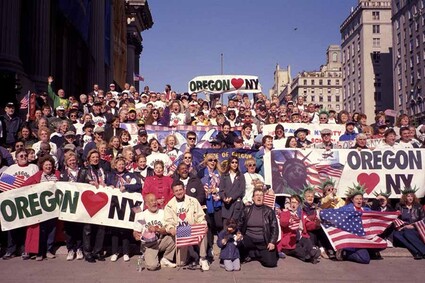Oregon Flight for Freedom linked country from sea to shining sea
Last updated 9/8/2021 at Noon

Oregon Flight for Freedom participants marched down Fifth Avenue in the 2001 Columbus Day Parade, a powerful symbol of unity from sea to shining sea in the wake of the September 11, 2001 terrorist attack in New York City. Jack McGowan of Sisters is front-row center, holding the American flag. photo provided
Jack McGowan was up early on Tuesday, September 11, 2001, listening to NPR as he does most mornings. The broadcast faded out and a bulletin announced that a plane had hit one of the towers of the World Trade Center (WTC) in New York.
McGowan’s first thought was that there had been a terrible accident. Then a second plane hit a second tower — and the world changed.
“You’re rocked back on your heels,” he recalled. “I yelled to [wife] Jan, ‘Oh, my God, Jan — we’ve got a terrorist attack!’”
McGowan had been living in Oregon since 1970, and was serving as co-executive director of the environmental nonprofit SOLV (Stop Oregon Litter and Vandalism). But he was a native New Yorker, and the attack hit home with great force.
“I watched the towers being built,” he recalled. “Two years before, I took Jan and [son] Travis to see my New York, and we went out to lunch at Windows of the World (the restaurant at the top of the North Tower of the WTC).”
The dark events of September 11, and the wound it inflicted on his country and the city of his birth came down hard on McGowan.
“All of a sudden, I just broke loose,” he said. “I cried and cried and couldn’t stop crying. The initial shock settled into profound grief.”
Flickering in his heart, beneath the grief, was a desire to do… something… a need to take some positive action in the face of tragedy. An opportunity soon presented itself.
Tapping his background in media, the TV station KGW asked McGowan to host local cutaways that were part of a national telethon to support 9/11 relief. At that telethon broadcast, McGowan connected with Sho Dozono, owner of Portland-based Azumano Travel and his wife, Loen.
Loen Dozono had an idea, what McGowan characterizes as “a bold act of perseverance, of looking terrorism in the eye and not blinking.” Dozono proposed enacting a “reverse Oregon Trail,” bringing Oregonians east to New York to show solidarity and provide an economic shot in the arm for a city that was pummeled, shut down, and reeling. They mulled the possibility of a bus caravan, but that seemed too slow and cumbersome.
“This had to be immediate,” McGowan said.
They had to fly. Planes had been grounded across the nation in the wake of the attack, and no one really knew what was going to happen with air travel in the coming weeks, or what threats civilian airliners might yet face. But they had to fly. And the idea for the Oregon Flight for Freedom was born.
McGowan put every bit of passion and emotion that had washed over him into helping make it happen. He wasn’t sure he could leave his responsibilities with SOLV to make the trip, but Jan insisted that he had to go. He needed to be “part of something that was larger than just grief.”
He was assigned to an advance team to prepare the ground in New York for what was swiftly becoming an enormous event.
In a 10-year retrospective published in The Oregonian in 2010, Sho Dozono recalled:
“A thousand Oregonians responded to our call, from all over Oregon and southwest Washington.
There were folks who had never been to New York; some had never flown before.
World War II battle veterans joined.
Grandparents brought their grandkids.
Whole families flew together.
Roger Hinshaw, president of Bank of America, took his two children out of school to join us.
Mayor Vera Katz had to overcome her fear of flying to lead us.
Nick Fish, a New York transplant, used all of his contacts in New York and arranged for a memorial at Union Square to honor the victims.
Firefighters; police officers; mayors from Eugene, Hermiston, and other small towns joined the growing number of political leaders.”
The organizers had to weigh the impact of what they were doing.
“The responsibility suddenly weighed so heavily on us,” McGowan recalled.
Was bringing 1,000 Oregonians to New York really the right thing to do? Was it too much of a burden on a city that was still reeling? Would they be making the Oregonians a target for a follow-on terrorist attack?
But it quickly became apparent that New York didn’t just welcome the Flight, “they were desperate for it,” McGowan said.
McGowan arrived in New York on October 1, where the Waldorf-Astoria Hotel waived room fees to put the Oregonians up. McGowan helped set up an international press office for the Flight, and liaised with a range of New York officials and media.
Then, he took a bit of time for himself.
“I went down [to lower Manhattan] the next day by myself because I needed to decompress — but I also needed time to mourn,” he said.
The area around what was being called Ground Zero was covered in thick layers of dust, and there was paper everywhere, scattered from thousands of offices in the collapsed Towers. There was a terrible smell of pulverized concrete, burning, and decomposition.
“Below Canal Street, the city had stopped,” McGowan said. “You could feel the oppressive sense on every single thing. People didn’t even look at each other… it was this unbelievable sense of shock and mourning.”
The pall of grief and mourning contrasted with an exuberant welcome for the Oregon delegation. Broadway entertainers performed for them at the Waldorf. The welcome created a very human roil of mixed emotions — resilience and the desire for joy contending with the somber weight of events.
“There was a certain sense of guilt,” McGowan said. “You’re not supposed to smile. But there was such a sense of welcome and sheer relief, I think, that we were there.”
McGowan reckons that the economic impact of a thousand Oregonians was welcome, but just “a drop in the bucket” in an effort to get the city back on its feet. The real impact of the Flight for Freedom was in knitting the country together, in making a tangible statement of solidarity.
“It was the psychological embrace that told New Yorkers, ‘You’re not alone,’” McGowan said.
And New Yorkers responded. The entire staff of the Waldorf-Astoria turned out on the steps and the sidewalk to welcome the Oregonians, waving American flags and cheering. Flight participants were invited to ring the bell at the reopening of the New York Stock Exchange, and were asked to participate in the city’s legendary Columbus Day Parade.
In his Oregonian retrospective, Dozono recalled, “Certainly the highlight of the trip for many was marching down Fifth Avenue in the Columbus Day Parade. Enthusiastic New Yorkers [yelled] ‘We love you, Oregone.’ We gave the T-shirts off our backs — ‘Oregon Heart NY’ — to our newfound friends along the parade route.”
Oregonians were treated to standing ovations in New York restaurants.

Oregon Flight for Freedom representatives rang the bell at the reopening of the New York Stock Exchange after the September 11 attacks. photo provided
For McGowan, the unity and solidarity on display during the Oregon Flight for Freedom represents a precious moment and an opportunity to stand upon the best of our ideals, a moment that he fears Americans have allowed to slip away.
“To say that we squandered it, maybe that’s too harsh,” he said. “But we missed it. Without a compass, we wandered into the wilderness that is America today.”
Jack and Jan McGowan have lived in Sisters for more than 14 years now. Jack continues his public service with the Sisters-Camp Sherman Rural Fire Protection District Board of Directors.
And no matter how far we’ve wandered in the 20 years since the September 11, 2001 attacks, McGowan recalls the Oregon Flight for Freedom with deep emotion and profound gratitude for the opportunity to help bring Americans together.
“I’m still so proud of that,” he said. “I’m so thankful I was part of that.”


















Reader Comments(0)